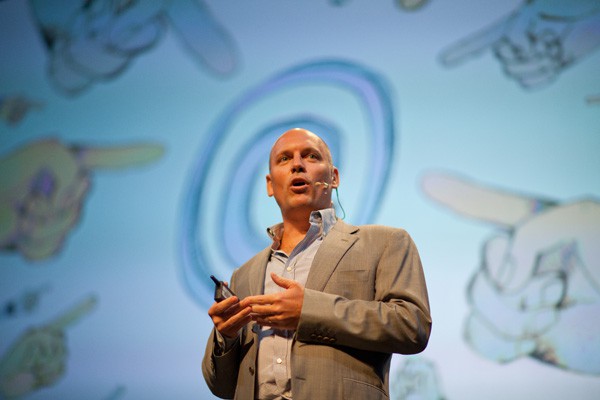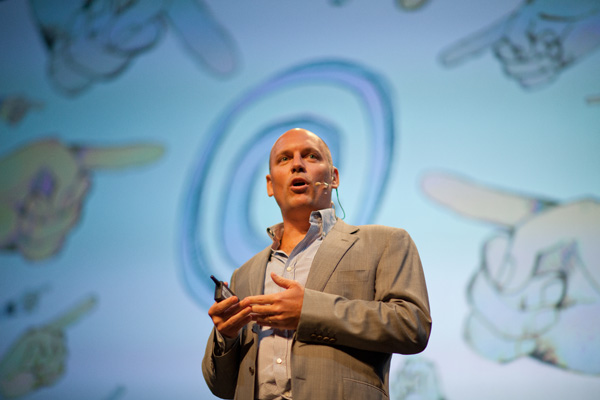Share
Two Stock Photographers Respond to Getty’s Licensing Model
Photo by Michael J. Treola There was mixed reaction to Craig Peters’ talk at Luminance back in September. Craig, Senior Vice President of Busines...

There was mixed reaction to Craig Peters’ talk at Luminance back in September. Craig, Senior Vice President of Business Development at Getty Images, spoke mainly about developing new models for content owners (i.e. photographers, videographers, illustrators, etc.) to license their work.
It’s a topic that, in and of itself, provokes a lot of strong feelings among photographers – not to mention the fact that Craig hails from a company that has its own set of advocates and critics for its licensing practices.
“New online publishing platforms means the world is open for anyone to create, publish, and share with billions of people,” said Craig. “This should be great for content creators, but general public doesn’t know about licensing and has little to no budget.”
In his talk Craig outlined, “a worldwide approach, one that evolves with the Internet, and one led by the content owners.” Check out the details of what he had to say in our video of his Luminance talk:
Since then, we’ve been more curious than ever to get the perspective of photographers today to learn more about how they view the powerhouse agencies, like Getty. So we spoke with two stock photographers who have worked with them in the past (and present):
Brad Mangin is a seasoned sports photographer who has been working freelance since 1993. He regularly shoots for Major League Baseball and Sports Illustrated. When MLB Photos and Sports Illustrated became business partners with Getty Images several years ago, Brad’s images were automatically hosted and licensed through Getty due to the partnership arrangement. He also continued to work with Duomo, which never formed a relationship with Getty. Brad still licenses his work through MLB Photos and SI Picture Sales, as well as through his own PhotoShelter archive.
Shannon Fagan got into the traditional world of stock photography in its heyday during the early 2000’s, when the industry was in the midst of a huge growth phase. At that time, Shannon saw stock as both a safe, predictable, and stable source of income, as well as a creative outlet. He was originally introduced to Getty by Art Director turned Deputy Director of Photography Rolf Sjogren, and approached them with a portfolio of ideas. He later signed with Corbis to diversify his approach, and also some of the royalty-free companies. Shannon is a former President of the Stock Artists Alliance and is on the Advisory Board for the Young Photographers Alliance.
We asked Brad and Shannon to share their thoughts and experiences on what it’s like working with the big stock agencies, and how they envision the future of image licensing.
What do you think is the biggest misconception about working with the big stock agencies?
Brad Mangin: I think a big misconception is that you will get rich and make tons of cash. Of course I am only speaking for sports photography, which is all I do. The days of making big money are gone. The market is overly saturated and there are way too many images online for editors and art buyers to sift through. The pie of money has been divided into too many slivers, resulting in less revenue for everyone. Sure, every once-in-awhile you can get lucky and make a really good commercial sale if your images are with one of the agencies that is licensed by the leagues to sell commercially (Getty, AP Images, etc.) but those sales are becoming fewer and fewer because of the over saturation of contributor content on the sites.
Shannon Fagan: That you have to hate the big guy. What do I mean by that? Well, working with stock agencies is a business decision, not a personal relationship. It’s not [the stock agencies’] fault that [photographers’] jobs came to an end. Since 2008 alone, we’ve seen an industry slowly tossed one curve ball after another in how individual photographers are contracted. The larger the agency, the more eyeballs pointed with mouse right-clicks to your images – plain and simple.
Some photographers argue that selling images through an agency is better than letting them “sit” on your hard drive. What’s your take?
BM: I do both. I market the heck out of my baseball images online through my PhotoShelter-powered archive of over 60,000 images going back to 1987. Photographers who let their images sit on their hard drives are missing the boat. These are your images. Do something with them!
SF: I understand the argument for not “selling out” and putting imagery into low-priced volumized collections, so long as the individual isn’t complaining about the industry overall in the next breath. Sitting on images for a niche opportunity is an argument, and probably the only business argument, for holding imagery back from the market.
What do you think about the sale percentage paid to photographers?
BM: The sales percentage paid to photographers should be 50% minimum. Heck, when MLB Photos started we got 60%! In the old days, the 50% that the agency kept paid for making dupes, editing, office space, salaries, marketing, printed catalogs, FedEx, etc. It was totally worth it to be 50/50 business partners with the agencies because they worked hard for you. Nowadays there are agencies that will only let their contributing photographers keep 30% of the licensing money – and that is not right. The big problem is that many photographers are signing these contracts and caving into the low percentage. Once you sign that contract for 30%, it will never go back up to 50%.
SF: There was a metric recently provided in an analysis report which said that any stock photo agency that gave more than 50% to their supply base of photographers was, over time, going to go out of business. If photographers want a larger percentage for their pictures, then they need to devise a new system that will allow for ways to receive more than 50%. And, to their credit, there are a few out there doing so.
I’m going to be brutally honest about photographers as a whole community: they are divided in a way that’s to the advantage of the agents and have failed to organize themselves against the business practices of buyers seeking fast, cheap, reliable imagery online. One has to accept that as a truth of the industry to argue percentages. Being a photographer is about being a business owner and, by default, a leader. If the latter is not fully understood, then what the photographer wants to make and what they can make won’t line up. That being said, I’d like to see an extra 20% paid across all large agency contracts as a whole. I’d like to see agencies operate more like frequent flier programs perking the economy class for loyalty, commitment, and the ability to supply what’s being asked for in their imagery research reports.
Do you feel like you can sell via an agency and still protect your images’ copyrights?
BM: Yes I do.
SF: Yes. And more so, the agency has an incentive to chase a stolen image, as well as the legal backing, operational systems, and tracking to do so.
Why don’t you think more professional photographers move away from agencies like Getty and set up their own shop where they could control the marketing, pricing, etc.?
BM: More and more art buyers and editors like dealing directly with the artists themselves. This is why I am doing it. If someone wants baseball, they know they can come to me and get most of what they need going back 25 years. I work hard with my blogging and social networking to keep my archive at the top of many Google searches.
SF: Photographers are not, as a whole, analytical business operators with long-term strategic, service-oriented interests in mind. Photography is becoming an increasingly sought after profession by individuals hoping to receive quick fame or side money based upon what the industry was like in the 1980’s during its Golden Era. There is no shame in this. It’s simply a market condition. Since this dream also continues to permeate in the art schools and photography programs, and since many will enter the profession from these backgrounds, the necessary reality-based business models are not easily put into practice.
It’s simply rare to find both commerce and creativity interests in this profession at a core level to actually do something dramatic. What’s more is that the profession will continue to be entered into by other non-photo professionals in a more rapid pace than ever before in history.
Now, that sounds like a lot of sour grapes, so let’s end on a positive note. Microstock and micropayment was built from the ability to crowdsource photography online. It’s allowing access to imagery that was formerly not affordable to the blogosphere and small business owner and serves as a counter against piracy when they may have been finding and using imagery illegally. The job of the photographer, as a career ambition, is to act smart and get positioned where the industry is going and to be a part of its exciting and constantly evolving future. Imagery is still selling at exclusive high paid licenses for those in it for the long haul and who are creatively in-tune. Professional photographers are best advised to hunker-down and tune out the things that can keep them from seeing the common-sense positioning of the industry.
Now it’s your turn – what do you think of Craig Peter’s talk? Do you agree with his vision for a content-owner based licensing model? Can photographers step up to the plate?



